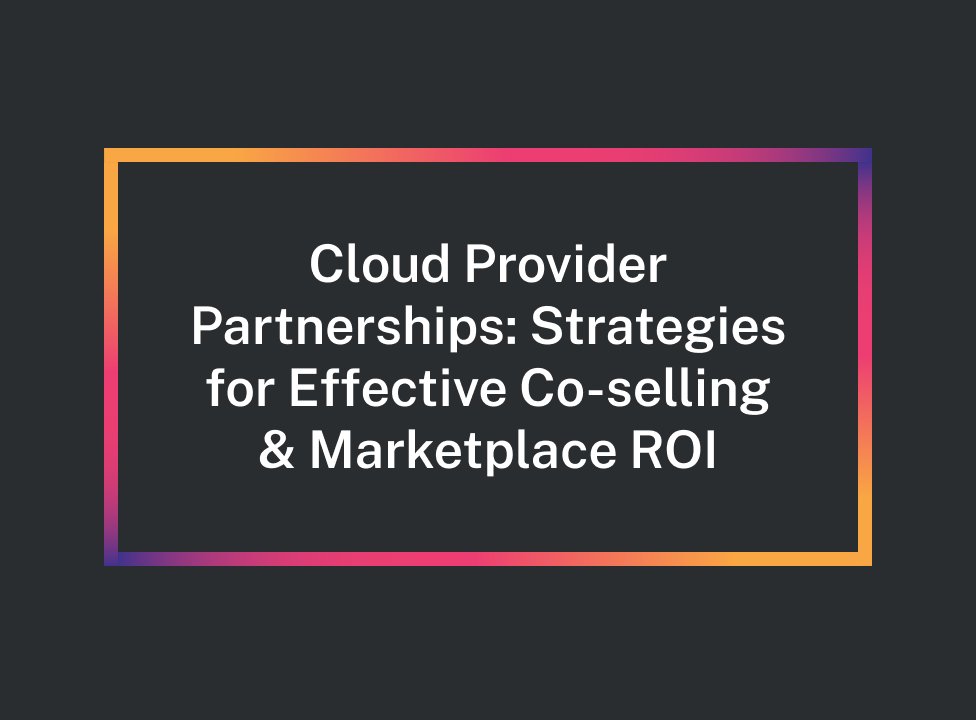Co-selling and leveraging marketplaces are effective strategies for achieving exponential growth for your organization. Today, more technology companies and systems integrators invest in building programs with Google Cloud, Amazon Web Services, and Microsoft Azure. If your team isn’t enabled on co-selling and marketplaces, you won’t be able to take advantage of these platforms’ benefits.
We’re lucky enough to have had Dan Stephen, Justin Forth, Maryam Lahiji, Tracy Sandhofner, and Joe Lamoureux join us for a panel exploring the differences between marketplace and co-sell programs and tips on how to be successful in these large cloud ecosystems.
Today, we’ll dig into the top takeaways from the panel that you can implement at your organization.
Separating Marketplaces and Co-selling
The first and perhaps most important point panelists made was leveraging marketplaces and co-selling are not the same. For clarity, marketplaces are one of many tools you can leverage while creating a co-sell motion.
However, panelists highlighted that even if you’re not co-sell ready, it’s good to put your solution on a marketplace as soon as possible. By establishing yourself in the marketplace, you’ll be able to begin building brand awareness and relationships.
Preparing Your Team
Before you dive into either effort, there’s a lot of upfront work for your team. You need to educate your internal resources on the value of co-selling and marketplaces while being realistic about the results. If your team anticipates seeing results from these efforts within a few weeks, they’ll be sorely disappointed. The reality is that both co-selling and marketplace initiatives take time to ramp up.
Tracy Sandhofner explained, “You have to be able to articulate the value of a co-sell relationship. Often it’s misunderstood that the value is that a cloud provider will bring you opportunities and exciting deals, which is simply not the truth.”
“You have to get buy-in from the executive team,” Tracy continued. “They have to be convinced of the value behind co-selling. The value is accelerating deals and increasing deal size. Of course, the connections you make with the account executives are valuable. If you get an account list, it gives you a foundation from which to build. An account executive isn’t going to tell you every account they work on and won’t waste their effort when you aren’t investing any time. They have to understand the true value of co-selling.”
It’s essential to appreciate that getting ready for co-selling is a ton of work that will take time to navigate. Start by figuring out your “better together” story is — how do end-users benefit from this co-sell motion? For most marketplaces, your customer benefits from easy access to your tool. On Microsoft Azure Marketplace, MACC (Microsoft Azure Commit to Consume), for example, customers can also benefit by utilizing their committed Azure spend towards their purchase.
Leading Indicators
You likely won’t see massive amounts of revenue or enormous pipeline changes in the first few months of establishing a co-sell motion. You won’t see results until you create a visible footprint. Engage with the platform sellers immediately and provide value — establish ownership internally.
Justin Forth takes every incremental win, such as a co-created blog, and turns it into something his team can understand while explaining the size of the marketplace. “This strategy gets the team excited about the incremental wins we’re building.”
Appreciate, and help your team appreciate, that the first steps are about investing in the marketplace. Just like a bank account, you have to invest to withdraw. Make investments early and often to see substantial returns over time.
Marketplace Challenges You May Face
Many panelists emphasized the importance of having the right buy-in from the organization and finding the right type of talent for that particular problem. In the early days, you’ll need a generalist that can help steer the ship and bring in the right people. As your efforts grow, bring on the right resources to get the job done, growing more specific over time.
While marketplaces and co-selling can provide significant opportunities for some organizations, they may not be ideal for you. Take the time up-front to determine if a cloud alliance is right for your company and technology, including if you’re ready to put in the work.
Once you commit to co-selling, be prepared for the unknown and be opportunistic. If Microsoft, Amazon, or Google shares an opportunity, say yes, whether or not you have the resources. Always remember there are many more companies they could ask for the opportunity, and they may not offer again.
Drive Results with Co-selling & Marketplaces
According to Joe Lamoureux, “The future of selling software is through clouds and marketplaces is the delivery vehicle.” Take action now to prepare your organization for future growth. Most important to achieving your goals with co-selling and marketplace initiatives is aligning your resources internally and preparing for success.
Thanks again to Dan Stephen, Justin Forth, Maryam Lahiji, Tracy Sandhofner, and Joe Lamoureux for sharing their insights on best practices for co-selling and leveraging marketplaces. If you missed the panel and want to watch the entire event, you can access it here by submitting the form. For more insights on effective marketplace strategies, explore tips for Optimizing Your AWS Sales Channel and Going to Market with Salesforce.
Join The 1700+ Leaders Transforming Partnerships
As a member of Partnership Leaders you will:
- Build and learn with the top partner people at the best companies around the world.
- Increase your impact and accelerate your career with proven resources, tools, and best practices.
- Grow a network of peers, partners, and advisors with common objectives.


